Data Driven Management Assignment: Project Review & Quality Control Tools
Question
Task:
Write a report to your senior management explaining your action plans to overcome all the
issues highlighted above. For each of the issue, you are expected to:
• propose necessary actions that must be taken by way of implementing the appropriate project
management processes
• provide examples of how these new control measures are to be implemented
You are also expected to include the following in your report:
1. A brief executive summary
2. An explanation of an effective and efficient project review and reporting mechanism for
monitoring and controlling purposes
3. The demonstrated use of the seven quality control tools (7QC) tools (and / or other quality
tools) to generate subcontractor / vendor performance data (provide examples – these could
be fictitious but practical data)
4. An explanation of an effective risk management plan
5 An explanation of the appropriate leadership style that you could adopt to manage this
project successfully
6. A conclusion section
Answer
Executive summary
The proposed study developed within the data driven management assignment is focused on investigating the lean project management which is a complex and data-driven management procedure that confines suitable options to use resources adequately. It is also an integral property of PRINCE2 project methodology which allows reducing and risking waste by incorporating various data visualization tools such as Kanban board, Gantt chart and WBS software. An effective project review is all about fulfilling the client requirements with quality tasks within the deadline. Different project review mechanisms have been included in the report. Leaders play a crucial role in project management. Strategic leadership has been explained in the data driven management assignment which mainly follows various strategies based on the leadership situation such as employee quality, performance, skill, knowledge, work environment, availability of resources and others. 7QC tools have been used within this study, which includes Histogram, Cause & Effect Diagrams, Control Charts, Scatter Diagrams, Pareto Diagrams, Check Sheets and Graphs. These statistical tools are used to improve and monitor the lean project process. Their applications concerning the case have been presented in details.
Introduction
Lean project management is a complex and data-driven management procedure that confines suitable options to use resources adequately. This data driven management assignment intends to explore effective project review and reporting mechanisms and demonstrate applications of 7 quality control tools. The data driven management assignment also provides a risk management plan to cope with various projects challenges along with understanding the leadership qualities of the project manager.
Explaining an effective project review and reporting mechanism
Project review needs to follow all the necessary project scopes along with the specific project schedule by which it gets a pathway to fulfill the necessary arrangements. Based on the PRINCE 2 methodology, the project schedule is developed in the initiation phase of the project examined in the data driven management assignment.
The entire review process of every project can be separated into eight steps which are as follows:
- Objective of review
It is essential to understand the scope and objective of the dream house development project along with its projected outcome. The objective review process illustrated in the data driven management assignment is mainly handled by the senior management department of the project to understand the entire project with its necessity and goals. Objective reviewing also helps the higher officials related to the project to understand various concerns and risks involved in this project (Zou, Kiviniemi & Jones, 2017). This process is conducted during the planning phase of the project based on the stages of PRINCE 2 methodology.
- Preparation
Preparation of the entire review process is crucial for the success of the entire reviewing process (Englund & Graham, 2019). The preparation process includes preparation of the documents required for the entire dream home project to complete, confirming the scope and aim of the project, the project completion duration determination and the format of the entire project.
- Sponsor interview
Sponsors play a demanding role in every project and in this dream home project, sponsors are the clients. Interviewing them can help the project team to structure and better understand the entire project. This also helps the project management team to understand whether their entire project plan and project hypothesis resonate with the demand of the clients. According to Zwikael and Smyrk (2015), the entire interview process also involves understanding the concerns of the project including its potential challenges, problems and risks. These interviews can be conducted during the initiation phase based on the Prince 2 Methodology.
- Project manager interview
The entire project hypothesis as presented in the data driven management assignment must be followed and understood by the chosen project manager for the successful completion of the dream home project (Chih & Zwikael, 2015). The project manager has to be persistent and open to the interview process, and the defensive mentality from the PM must not be entertained by the project management team. The manager also has to show mentality and attitude towards lean practices to make the entire PRINCE 2 based project more valued and efficient.
- Stakeholder interviews
Interviewing the stakeholders can be useful for identifying their needs, demands and expectations from the project during lean. Usage of various lean tools is proven to be useful in terms of providing value-added services to the stakeholders by considering all the PRINCE 2 based knowledge areas. Developing the Inform-involve-influence model also plays an important role in further analysis of the project throughout the interview process (pmm, 2020).
- Analysis
It is stated herein data driven management assignment that after completion of every interview, all the outputs must be reviewed thoroughly so that they can be analyzed and against the original hypothesis and concerns. This analysis process can help to ensure that the draft findings complete and effective.
- Drift conclusion
The final draft conclusion is discussed in details with the sponsor (client) for the dream home project. If the findings are appropriate, the draft findings can also be introduced to the project manager to understand the findings and the reason behind the findings via PRINCE 2 methodology. This reviewing leads to the generation of the final document which helps the project team to give a proper head start for the project.
- Publishing final review
Final review publishing is done to ensure that the entire document contains proper conclusion and an executive summary which includes the original scope and objective of the project and high-risk factors (pmm, 2020).
Issues and Actions: Low quality work by sub-contractors and vendors due to a lack of proper reporting
The reporting mechanism involves the fact that a hierarchical structure is followed where a certain group of people report to an individual relating to any issues with a project. Based on the case, it has been stated that a proper reporting mechanism has not been developed for contractors and subcontractors leading to low performances. Therefore, a reporting structure can be implemented in order to deal with the issue identified in the data driven management assignment. For example- various organizations involved in product sales involves salespersons who directly report to the general manager. In a similar way, the project manager can make sure that the contractors and vendors report to the project supervisor in regards to development processes and raw materials required. The supervisor can take decisions and report to the project manager in case of major changes being required.
Demonstrating the application of 7QC tools
The main motive of 7QC tools is to solve the quality problems of the lean project and have been presented below within this data driven management assignment:
- Histogram
The histogram is a statistical quality control tool used in lean project management which is also known as a frequency distribution diagram. Through this tool, the regularity and rate of manufacturing products can be identified to accomplish the target of the project. As commented by Memon et al. (2019), the main motive of using this tool is to represent the frequency of gathered data and information in table format using bar graphs. PRINCE2 methodology can utilize this toolfor determining the profitability ratio and it will help the project manager to check the regularity of products.
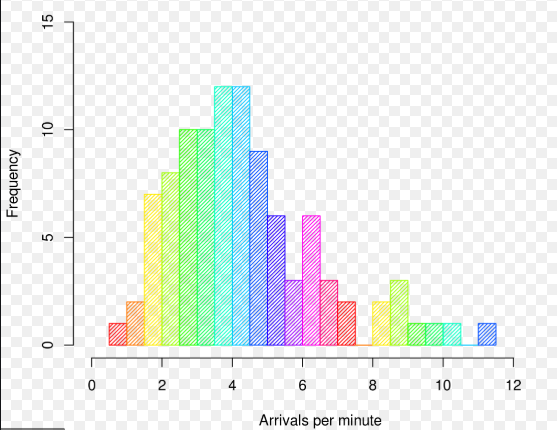
Figure 1: Histogram
(Source: Memon et al., 2019)- What is the role of Pareto Diagram in the case of data driven management assignment?
Pareto diagram explored in this segment of data driven management assignment is used in a project to analyze frequency-based quality problems while construction of the client's dream home and this chart consists of both line graphs and bar graphs. As per the views of Dharma, FIkatrinasari, Purba and Ayu (2019), this tool arranges the materials according to their magnitude and mainly used in SPC. PRINCE2 methodology can use Pareto diagramto monitor and control the lean project processes. It will help to improve the quality of manufacturing materials used for building home and balance the budget of the project. Based on the scenario, this tool will help the project manager to identify the frequency of the defects to gain quality decision making based on construction.
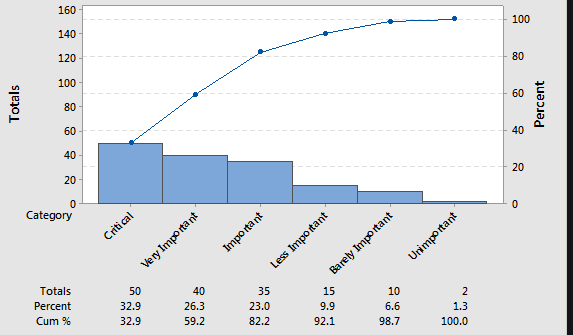
Figure 2: Pareto Diagram
(Source: Dharma et al., 2019)- Cause & Effect Diagram
Cause & effect diagram is a quality control tool that is used to evaluate the reason behind the occurrences of something or which might occur in the future by identifying the potential causes into small sub-divisions. These tools help to depict the systemic relationship between the cause and the results. This tool mention in this segment of data driven management assignment is applicable to identify the root cause of the construction issues and then identifies the main problem behind the failure of the project (Neyestani, 2017). This tool can be used in PRINCE2methodology to identify the cause for project delay and will help to rectify the problems.
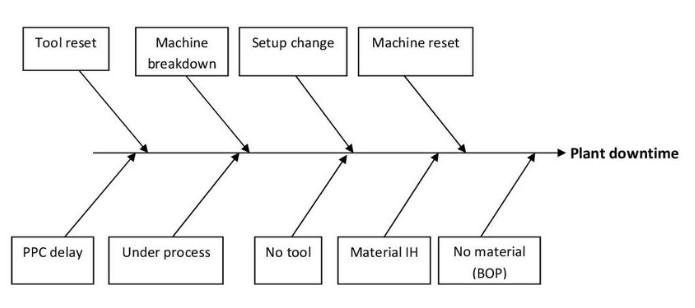
Figure 3: Cause & Effect Diagram
(Source: Neyestani, 2017)- Control Charts
Control charts are used in lean project management to evaluate the behavior, along with the stability and productivity of the project. The proposed data driven management assignment clarifies that the control charts are mainly used in a project to evaluate the process which continuously changes with time. In this home construction project, this chart can be applied to improving the quality of products. Control charts can be used in PRINCE2 methodology to eliminate the faults present in the manufacturing phase. According to Goedhart, Schoonhoven and Does (2017), it is noted in this section of data driven management assignment control charts help to provide proper guidance to the project manager about when to leave a process and when emergency action is required.
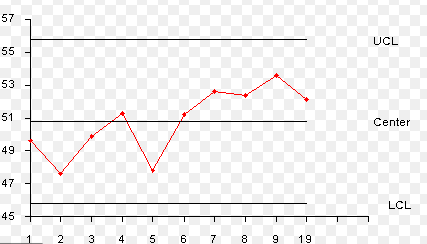
Figure 4: Control Charts
(Source: Goedhart et al., 2017)- Scatter Diagrams
A scatter diagram is a statistical quality control tool that helps to understand the relationship between two variables or process while constructing the dream home. In lean project management, this tool can be used to depict the change in independent variables which might change the dependent variables. As commented by Videiro, Giraldo, de Sousa, dos Santos and Sagrilo (2019), this diagram comprises various dots which are the quality method to identify the non-linearity of the project. In this scenario, this tool can be used to observe whether there is a positive or negative relationship between the two variable x and y. This quality control tool defined in the data driven management assignment can be used in PRINCE2 methodology; though which the project team can monitor and control the lean project processes.
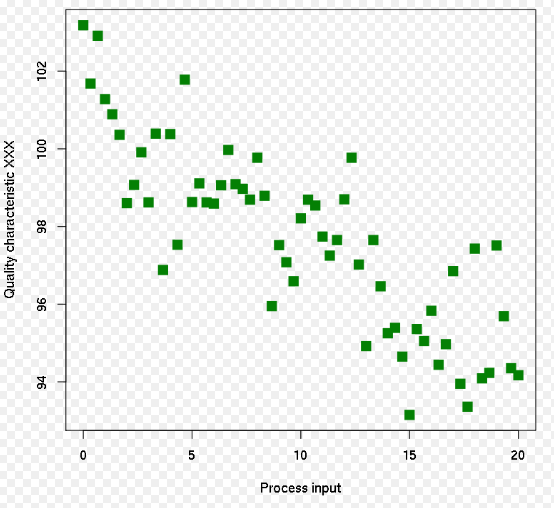
Figure 5: Scatter Diagrams
(Source: Videiro et al., 2019)- Graphs
In lean project management, various types of graphs are used to represent the information and data in pictorial form. The data driven management assignment explores the words of Goedhart et al., (2017) that with the help of graphical representation, the construction team can easily identify and understand the meaning of the gathered information. PRINCE2 methodology can use this tool for accomplishing the goal and eliminating the future risks. In lean project management, graphs are applicable to plan and schedule the tasks. Based on the scenario this tool can be used by project manager effectively for understudying the significance of medium and large-sized data.
- Check Sheets
In lean project management check sheets is a quality control tool that is used to gather the information and data in real-time. As stated by Neyestani (2017), it is noted herein data driven management assignment that there are mainly five types of check sheets such as defect sheets, probability distribution sheets, defect cause sheets, tracking sheet and defect location sheets. All these sheets are applicable in this scenario while gathering a high amount of statistical data and it will help to track the budgetary process effectively. PRINCE2 methodology can use these toolsfor identifying and eliminating the faults present in the lean project.
What is the idea behind developing an effective risk management plan for the case scenario examined of data driven management assignment?
Lean project management demands high accuracy in procurement and logistics along with leadership quality of project manager to minimize project waste and inventory cost. Various possible risks and their management processes have been presented in details below.
Home development construction deals with various distinct types of contract process to purchase raw materials and equipment legitimately. Commercial contractual obligations can be strategic or operational based on project requirements and preferences of customers. The fact that the project deals with development of a dream home and not a new system or functional unit indicates that commercial obligations are operation based in this case. To ensure effective performance in the commercial risk management process, the PM needs to include basic premises such as guidance, leadership skills and support management to determine the efficient procedure of contracting and procurement services.
Each construction project, especially lean project principles within PRINCE2 project methodology, consists of several distinct risks that create constant threats and challenges for the PM to execute premeditated project plans. Project risks can be identified by implementing various types of project tools such as project charter, Kanban board and WBS software which increases data visibility by incorporating internal database and project phases (Mesa, Molenaar & Alarcón, 2019). These risks mentioned in the context of data driven management assignment are adequately capable of setting limitations to perform various project tasks.
Issues and Actions: Failure of Project Manager in making informed decisions
As the project manager failed to monitor project requirements effectively, the manager needs to justify contact validity and enforceability to determine effectiveness and capability of the subcontractors to mitigate home construction risks. Development of a systematic and interdisciplinary risk management plan is inevitable to ensure collective productivity within the dream home construction project to satisfy client requirements and preferences while eliminating business associated risks. For example- In case of organizations involved in product sales, the manager can conduct meetings with various stakeholder groups in order to make a decision. Similarly, in this case of data driven management assignment, the project manager can meet with the project supervisor and board of directors in order to present the issues and to make decisions. Information can be gathered with the use of software systems such as the Management Information System (MIS) in order to develop a proper development framework.
Best Practices of Risk Management that can be implemented for the project
Implementation of appropriate risk management plans in regards with the data driven management assignment can be an effective alternative to escape from liability and trust issues within the contract process.
Transparency Creation: To amplify project growth, the pm needs to increase transparency within contracts to eliminate traditional risks and uncertainties (Hopkin, 2018). Agreeing upon certain procedures of procurement and supply chain operations based on client requirements is essential for the proper development of the dream home.
Review Process: Proper responsiveness and clarity are essential in business contracts as it allows reducing overhead costs and revenue losses. The PM needs to review various occupational hazards and miscommunications regarding deceptive involvements within the contract process. The PM also required navigating the risk register and projecting charters to identify the source of risks. During the development of the dream home as explored in the data driven management assignment, various problems may occur. These problems may include loss of life due to sloping issues, improper evaluation of budgets for the dream home project and a lack of proper implementation. The review process can help to identify the issues and the use of brainstorming can help to deal with the problems efficiently.
Risk Transfer: Risk transfer is an inevitable process of lean project management as it allows the PM to resolve risks adequately to succeed during the construction process (Dowson, Bryde, Marcano Al-Hilou&Douglas, 2019).
Issues and Actions: Stakeholder issues contributing to major risks for the project
As several subcontractors failed to assure utmost quality in procurement goods and contract process, the PM needs to use legal obligations and regulatory affairs to shift risks towards various distinct types of suppliers and vendors associated with the home development project. In order to mitigate issues with several occupational hazards and limitations in commercial contractual agreement, the PM needs to inform key stakeholders such as the board of directors, clients, operational manager to incorporate effective decisions whether the contract should be terminated or not. Various internal meetings and conferences are required to perform to optimize various risk transfer criteria such as finances and legal actions. For example- In case of organizations involved in sales, performances of employees are evaluated based on their targets achieved. Similarly, review software can be utilized in this case, in order to evaluate stakeholder issues and performances.
The concept of Contract lifecycle management (CLM) defined in the data driven management assignment refers to a systematic and automated review software which allows reducing risks and uncertainties within the project through contract negotiation and management process between stakeholders and third parties (Christianson, 2017). Various important aspects of CLM can be effectively implemented to determine efficient contract collaboration and communication between involved parties. In regards to the case, implementing CLM processes can help to ensure proper development of communication between stakeholders such as the project manager, supervisor, general manager, chief financial officer and the board of directors of the dream home construction project. This implementation can be made in the planning phase of the project based on the PRINCE 2 methodology.
Issues and Actions: Problems relating to improper leadership and actions that can be taken to manage the project
Controlling the employees who are assigned for various tasks to maintaining work quality, leaders are one of the most important parts in project management (Muller& Turner, 2017). The dream home project is a construction project where several activities have to be maintained by the leaders during the progression of the entire PRINCE 2 based project. In respect to this situation depicted in the data driven management assignment, proper leadership helps to improve the project and elevate the quality of the entire project. Strategic leadership is a well-known leadership style and popular also. One of the most important aims of lean practices in PRINCE 2 project management illustrated herein data driven management assignment is to minimize waste production during the project operation. To achieve that, the leader must know the skills and competencies of the stakeholders, especially workers involved in the project operation. For example- In case of various other organizations, organizational leaders are involved in the use of a participative leadership style which involves meeting with employees, managers and board of directors in order to develop a new idea. Based on this project case, leaders have to conduct assessments of performances of the workforce and ensure proper development of coordination among team members.
Another aim of the lean practice mentioned in the data driven management assignment is to deliver maximum value through the project work by effective and efficient utilization of the resources which includes both the raw materials and workforce. Lack of capability and knowledge can lead to ruining both the aims of lean practice. Leaders play the most important role in this situation as they are in control of the workforce along with the utilization of raw materials (Tabassi et al., 2016). The leader must understand which resources have to use where and by whom to gain the PRINCE 2 knowledge areas. Proper coordination among the workers during the project work is also necessary for achieving maximum output and efficiency in the project (Berg & Karlsen, 2016). Strategic thinking offers flexibility and agility in the leadership activity of the leaders which helps the leaders to control and maintain different types of employees within a team or project without disturbing the work culture and PRINCE 2 methodology. However, the investigation on data driven management assignment clarifies that strategic leadership is a challenging task for leaders as the leaders have to keep in mind about every trait of every employee and workers who are involved in the PRINCE 2 based project. To make the entire dream home project efficient, the leader must choose his workforce properly and allocate tasks according to their capabilities.
Conclusion
Lean project management is a data-driven management method that uses real-time project data to determine project requirements to incorporate continuous improvement development programs. Based on the given scenario on data driven management assignment, it can be concluded that the PM needs to uphold respective leadership skills and experiences to incorporate effective construction contracts to eliminate risks and other affiliates.
Reference List
Berg, M. E., &Karlsen, J. T. (2016).A study of coaching leadership style practice in projects. Management Research Review, 39(9), pp. 1122-1142. data driven management assignment Retrieved on: 21 January 2020, from: https://www.researchgate.net/profile/Jan_Karlsen2/publication/308271302_A_study_of_coaching_leadership_style_practice_in_projects/links/58b3f0de92851cf7ae91e3fc/A-study-of-coaching-leadership-style-practice-in-projects.pdf
Chih, Y. Y., &Zwikael, O. (2015). Project benefit management: A conceptual framework of target benefit formulation. International Journal of Project Management, 33(2), pp. 352-362. Retrieved on: 21 January 2020, from: https://openresearch-repository.anu.edu.au/bitstream/1885/35011/14/01%20Chih%20and%20Zwikael%20Project%20benefit%20management%202015.pdf
Christianson, G. (2017). Implementing Lean into Cloud-based Project Management Programs for a Small Construction Company.Unpublished manuscript, Milwaukee School of Engineering. 1(1), pp. 3-5. Retrieved on: 21 January 2020, from: https://www.researchgate.net/profile/Gage_Christianson/publication/325107904_Implementing_Lean_into_Cloud/links/5af74ad1a6fdcc0c031654cf/Implementing-Lean-into-Cloud
Dharma, F. P., Ikatrinasari, Z. F., Purba, H. H., &Ayu, W. (2019). Reducing non conformance quality using pareto principles and fishbone diagram. In IOP Conference Series: Materials Science and Engineering, 8(1), pp. 91-98. Retrieved on: 21 January 2020, from: https://iopscience.iop.org/article/10.1088/1757-899X/508/1/012092/meta
Dowson, J., Bryde, D. J., Marcano, A., Al-Hilou, M., & Douglas, J. A. (2019, September). Lean Project Management as a facilitator of Organisational Learning. Data driven management assignment In BAM2019 Conference Proceedings.British Academy of Management., 1(1), pp. 1-9. Retrieved on: 21 January 2020, from:http://researchonline.ljmu.ac.uk/id/eprint/12089/1/BAM%202019%20contribution718%20%28lpm%29.pdf
Englund, R., & Graham, R. J. (2019).Creating an environment for successful projects. Berrett-Koehler Publishers. Retrieved on: 21 January 2020, from: http://www.academia.edu/download/60636591/Creating_Environment_highlights20190918-91322-owoptn.pdf
Goedhart, R., Schoonhoven, M., & Does, R. J. (2017).Guaranteed in-control performance for the Shewhart X and X control charts. Data driven management assignment Journal of Quality Technology, 49(2), pp. 155-171. Retrieved on: 21 January 2020, from: https://www.tandfonline.com/doi/abs/10.1080/00224065.2017.11917986
Hopkin, P. (2018). Fundamentals of risk management: understanding, evaluating and implementing effective risk management. Kogan Page Publishers. Retrieved on: 21 January 2020, from: https://pdfs.semanticscholar.org/736a/c6d12a12a374abd4391c0ac395f1444c337c.pdf
Memon, I. A., Jamali, Q. B., Jamali, A. S., Abbasi, M. K., Jamali, N. A., &Jamali, Z. H. (2019). Defect reduction with the use of seven quality control tools for productivity improvement at an automobile company. Engineering, Technology and Applied Science Research, 9(2), pp. 4044-4047. Retrieved on: 21 January 2020, from: https://pdfs.semanticscholar.org/2e0b/908a32d770791c66a209db026b737ffd60a2.pdf
Mesa, H. A., Molenaar, K. R., &Alarcón, L. F. (2019).Comparative analysis between integrated project delivery and lean project delivery.International Journal of Project Management, 37(3), pp. 395-409. Retrieved on: 21 January 2020, from: https://e-tarjome.com/storage/panel/fileuploads/2019-04-09/1554785659_E11973-e-tarjome.pdf
Muller, R., & Turner, J. R. (2017).Project-oriented leadership. Routledge. Retrieved on: 21 January 2020, from: https://www.researchgate.net/profile/Ralf_Mueller7/publication/258641406_Project-Oriented_Leadership/links/55db0f9008aeb38e8a8a4650.pdf
Neyestani, B. (2017). Seven basic tools of quality control: The appropriate techniques for solving quality problems in the organizations, 4(1), pp. 85-91. Data driven management assignment Retrieved on: 21 January 2020, from: https://papers.ssrn.com/sol3/papers.cfm?abstract_id=2955721
pmm. (2020). 8 easy to follow steps to conduct a project review.Retrieved on: 3 February 2020 from: https://www.pmmajik.com/8-easy-to-follow-steps-to-conduct-a-project-review/
Tabassi, A. A., Roufechaei, K. M., Ramli, M., Bakar, A. H. A., Ismail, R., &Pakir, A. H. K. (2016). Leadership competences of sustainable construction project managers. Journal of Cleaner Production, 124(1), pp. 339-349. Data driven management assignment Retrieved on: 21 January 2020, from: https://tarjomefa.com/wp-content/uploads/2018/07/TarjomeFa-F962-English.pdf
Videiro, P. M., Giraldo, J. S. M., de Sousa, F. J. M., dos Santos, C. M. P. M., &Sagrilo, L. V. S. (2019). Long-term analysis using a scatter diagram key region to evaluate the extreme response of steel risers. Marine Structures, 64(1), pp. 322-340. Retrieved on: 21 January 2020, from: https://www.sciencedirect.com/science/article/pii/S0951833918302491
Zou, Y., Kiviniemi, A., & Jones, S. W. (2017).A review of risk management through BIM and BIM-related technologies.Safety science, 97(1), pp. 88-98. Retrieved on: 21 January 2020, from: http://livrepository.liverpool.ac.uk/3006119/1/Accepted%20Authors%20Version.pdf
Zwikael, O., &Smyrk, J. (2015). Project governance: Balancing control and trust in dealing with risk. Data driven management assignment International Journal of Project Management, 33(4), pp. 852-862. Retrieved on: 21 January 2020, from: https://openresearch-repository.anu.edu.au/bitstream/1885/35959/8/01%20Zwikael%20and%20Smyrk%20Project%20governance%20balancing%202015.pdf












